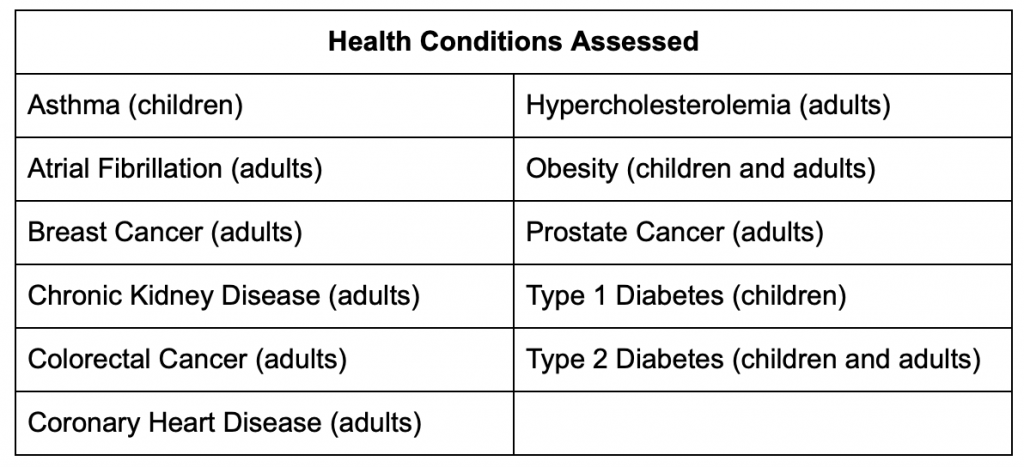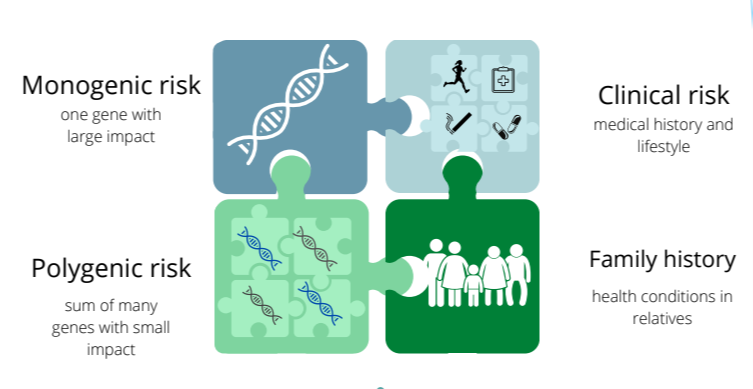Risk Report Explainer
Participants
Risk Report & Results
What is a Polygenic Risk Score (PRS)?
Everyone has thousands of genetic differences. Some genetic differences can slightly increase the risk for developing a health condition. A polygenic risk score (PRS) is made by adding up these small genetic risks. It is called polygenic risk because “poly” means “many.” A PRS is used to estimate the overall risk someone has of developing a health condition. PRS is a new method for estimating risk. Scientists are still working to improve PRS for different conditions. This study is trying to see if these risk estimates are helpful for you and your doctor(s). You should talk to your doctor about your results from this study. Your doctor may recommend changes in your healthcare.
What is the Genome Informed Risk Assessment (GIRA) or health risk report?
The Genome Informed Risk Assessment (GIRA) is the overall report from this research study. This report says if you/your child are at high risk for any of the health conditions studied. “High risk” means that you have a higher chance of getting a condition than the average person. This study looked at 9 conditions for adults and 4 conditions for children under 18.

This report has information about health risks including genetic (one or more genes), you/your child’s health history, and family health history. If you were found to be at high risk for one or more conditions, you can learn more about your risk in the “Understanding Your Risk” pages. You can speak to a study staff member about your results. This report may be put in your electronic health record and will be given to your doctor. It contains a summary of your risk factors, as well as the gene reports and family history information described in the consent form.

What is a monogenic risk?
A single difference in one gene can have a big impact on a person’s risk for developing a health condition. This is called monogenic risk because “mono” means “one.” For adults in this study, your health risk report includes genetic testing results for a small number of monogenic risks. Children in this study were not tested for monogenic risks. You should talk to your doctor about your results from this study. Your doctor may recommend changes in your healthcare.
How should I talk to my doctor about my results?
You should share this report with your doctor. You should ask your doctor what the results mean for your health. You should ask your doctor to help you follow any recommendations made in the report.
What are the possible results for each condition?
You can receive two types of results for each condition tested. These results will either be ‘high risk’ for a condition OR ‘not at high risk’ for a condition.
You can be ‘high risk’ for the following reasons:
- You had a positive monogenic result. A positive monogenic result means a genetic difference in one of your genes that is known to increase risk was found. OR
- Your PRS was above the study threshold for a condition. The study “threshold” is the point at which someone’s risk for developing a condition is higher than the average person. OR
- You have one or more close family members with the condition.
You can be ‘not at high risk’ for the following reasons:
- You had a negative monogenic result. A negative monogenic result means no genetic differences that increase risk were found. AND
- Your PRS was below the study threshold for a condition. The study “threshold” is the point at which someone’s risk for developing a condition is higher than the average person. In this study, the researchers set a specific threshold to indicate high risk that is unique to each condition. OR
- You did not have a strong family history for the condition.
How accurate are these results?
The GIRA health risk report gives a summary of many different types of risk factors. The accuracy of your family history risk depends on how much information you know about your relatives. The accuracy of your clinical risk factors depends on responses to the surveys and information from your electronic health record. Your genetic risk is made up of monogenic and polygenic tests. Monogenic tests have been around for a long time and have clear recommendation guidelines. Your polygenic risk score results are based on what science currently knows about genetic differences that impact a person’s risk for these conditions. The GIRA health risk report is not diagnostic. This research study measures risk (or the chance) of developing a health condition. Scientists cannot know for sure who will develop a disease and who will not. Health conditions can have multiple causes.
Genetic research studies need a large number of diverse participants to answer questions about our genes. Many polygenic risk scores were developed using data mostly from people of European descent. The study PRSs may not be as good at estimating risk in people who are not of European descent. This study tried to make PRSs that used genetic information from people of many different races, ethnicities, or ancestries. Where possible, the results have been validated (or confirmed) in people from four populations: Asian descent, African descent, European descent, and Hispanic/Latino descent. However, this type of information was not always available for every condition. This may impact how well your results estimate your risk for the health conditions. Please refer to the methods section to learn more about how this limitation may impact your results.
You may identify with more than one, none, or all of the listed populations. Across the different results you receive in your GIRA, some may still be meaningful even if you don’t identify with the populations mentioned. You should discuss all of the results you receive with your doctor. Your risk likely falls within the range of risk presented in the report. Your participation in this study may help improve health care for all people in the future.
What does it mean if I am at high risk for one or more conditions?
Being at high risk for one or more conditions means you are in the top 2-10% of the population for developing a condition based on your polygenic risk score. This means you have a higher chance of developing that health condition than the average person but does not mean you will definitely develop the condition. You may be at high risk due to your genetic results or family history. The “Understanding Your Results” pages in this report will help you understand what your high-risk results mean for your health and your medical care.
What does it mean if I am not high risk?
Being defined by the study as not high risk does not mean you are at low risk for developing that condition. Your overall risk for any of these conditions could still be higher than the average person based on factors that were not looked at in this study.
What if I already have one of the conditions studied and I am found to be at high risk?
There are many causes that can lead to developing a health condition. Other aspects of life such as lifestyle, environment, random chance, or other genetic differences not studied may be part of why you were diagnosed with the health condition.
What if I already have one of the conditions studied and I am not given a high-risk result?
There are many reasons that someone develops a health condition. This research study measures risk from certain causes (such as your genetics and family history). Sometimes people who do not have any risk factors will still develop disease. Lifestyle, environment, random chance, or other genetic differences not studied may be part of why you were diagnosed with your health condition.
What do these results mean for my family?
Monogenic risk has been studied for a longer time and we have more information about these genes. We know that your monogenic risk is important information for your blood relatives to know. PRSs are new and are still being studied. We do not currently know what your PRS results mean for your blood relatives. You should talk with your family members and they should discuss your family medical history and your test results with their own doctor(s).
Could my results change?
Your genes do not change, but science does. New tools to estimate risk could become available. The interpretation of your genetic differences could change. These research results were generated using the most up-to-date knowledge and information available at the time this report was written.
What other factors might influence my risk that are not accounted for?
This report is based on what we currently know about genetic differences that impact a person’s risk for the conditions tested in this study. However, there are many factors that influence risk. Some of these factors are understood by scientists and doctors, but there are many factors that are still unknown. Some factors change over time like a person’s age, lifestyle, environment, medications, or diet and their risk for disease can change as well. People can have genetic differences that have a small or large impact on risk. Not all genetic differences that influence risk for disease were tested in this study. Family history and clinical risks factors were evaluated based on the information available. If any of the information used to estimate risk was missing, your risk estimate may not be as good. Children were only tested for a few of the conditions included in this study. A list of the conditions tested can be found on the first page of this report. Please refer to the methods section to help understand how the risk estimates apply to you.
